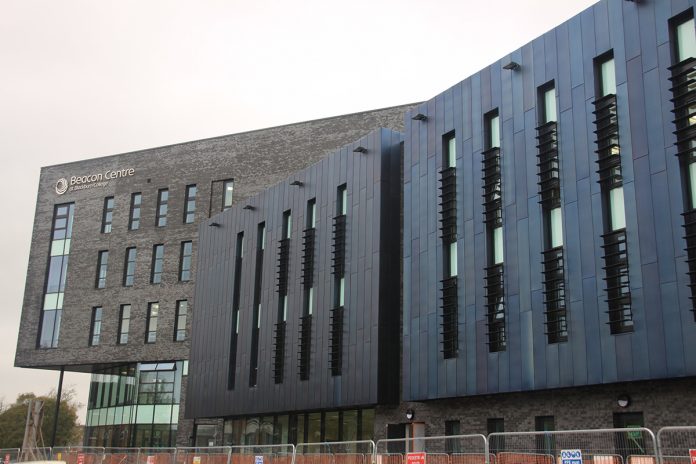There is no question that a contractor can construct better quality buildings, build them faster and provide exceptional eco-benefits, using Hemsec SIPs
A leading manufacturer of Structural Insulated Panels (SIPs) and other panel types used in modular construction, is gearing up for further growth.
As the UK construction market moves to find new, cost-effective and innovative ways of supplying the multi-faceted demands of commercial, industrial and residential developers, Hemsec is rolling up its sleeves for its latest phase of innovation.
Hemsec, established as an entrepreneurial start-up in 1928, has since become one of the largest manufacturers of insulated panels for controlled environments in the UK, and is a leading manufacturer of SIPs, as well as external and carrier panels for the building industry.
Hemsec SIPs, External and Carrier panels are key pieces in the modular jigsaw
Hemsec has a number of products which are increasingly popular throughout the construction industry.
Their External panels cut the overall cost of a project because they achieve so much in a single step. The panels’ inherent strength reduces the need for as much secondary supporting framework, they give superb insulation as well as coming in a range of colours to give an aesthetic finish to the building.
Their Carrier panels are externally fixed, fire-resistant wall and roof panels with low-air permeability, which can reduce the overall buildings CO2 emissions. Carrier panels allow the contractor to apply a range of external cladding options and greatly enhance the energy performance of a building at the same time.
It is Hemsec SIPs, however, which the company sees as offering the greatest positive impact on the construction industry for a variety of reasons. There is no question that a contractor can construct better quality buildings, build them faster and provide exceptional eco-benefits, using Hemsec SIPs.
“Relatively few people in the building industry realise what a SIP is capable of achieving, and even fewer realise that a SIP is a load-bearing structure,” says Hemsec commercial manager Chris Griffin.
“While it’s easy to integrate our SIPs with a wide range of construction materials (and we are very much in favour of collaborating with other materials manufacturers), it’s important that the UK SIPs sector educates the construction industry in just how much builders can achieve with SIPs alone.”
Hemsec is developing CPD material which you can discuss further by contacting the company, and has commenced an eight-part series about SIPs on its website.
Increased quality means greatly reduced snagging
99% of customers now report snags to their builder since moving into a new home, according to the NHBC’s National New Home Customer Satisfaction Survey published in March 2019.
This can be a thing of the past when SIPs are more widely adopted for the basic core structure of a building.
Unlike frames made of materials such as timber and steel, SIPs don’t move after a building has been put up and this is one of the main reasons why they offer such high quality.
Future Homes Standard – low carbon homes
There has been mixed response to Chancellor Philip Hammond’s Spring Statement regarding the introduction of the Future Homes Standard and our take is, why wait until 2025 to build energy-efficient, high-quality homes?
The ‘I’ in SIPs stands for ‘Insulated’. Using SIPs in the main structure of a building – ideally walls, roof and floors – means there is already no need for gas fuel. The insulation means heat is retained to a far higher degree than with traditional materials and thus electricity is more than adequate as the sole fuel.
Versatility in building design
Architects can design more innovatively and solve more practical construction issues when SIPs are specified, because they are so versatile. This is true whether the project is a large commercial or industrial building, a multi-million pound home or an affordable residential property.
Hemsec is increasingly receiving enquiries for panels which enterprising builders then make into kits of their own design, giving them a unique edge over their competitors.
Collaborating in the supply chain
One of the reasons for Hemsec’s consistent growth over the years is that an entrepreneurial spirit and ability to respond to market needs are part of its DNA.
This is of significant value to the industry, which is calling for more innovation and collaboration across the sector.
Andrew Carpenter, chief executive at the Structural Timber Association (of which Hemsec are active members), said in the May issue of PBC Today: “It’s important to try and improve the performance of the UK construction industry through collaborative working and integrated supply chains.”
Mark Farmer, author of the industry-changing Modernise or Die review, said in the same issue: “The offsite manufacturing supply chain is not vertically integrated…the point of breakdown is land-led developers or investors not getting comfortable with the idea of early engagement with a manufacturing partner.”
One of Hemsec’s core values is Partnership, and as a leading manufacturer of arguably the most ideal building material for modular construction, it is open to approaches from all walks of the sector for engagement and collaboration.
Owen Jones
Marketing Developer
Hemsec
Tel: +44 (0) 151 426 7171
Twitter: @HemsecPanels
Please note: this is a commercial profile.














